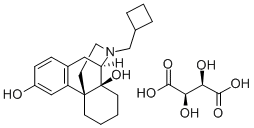Description
Butorphanol (tartrate) (Item No. 23812) is an analytical reference material categorized as an opioid. Butorphanol is regulated as a Schedule IV compound in the United States. This product is intended for research and forensic applications.
Uses
Analgesic;
antitussive.
Definition
ChEBI: The (S,S)-tartaric acid salt of butorphanol. It is used for relief or moderate to severe pain.
brand name
Stadol (Bristol-Myers Squibb).
Biochem/physiol Actions
κ/μ opioid receptor agonist.
Mechanism of action
Butorphanol is a strong agonist at κ opioid receptors, and through this interaction, it is five times
more potent than morphine as an analgesic. The κagonists have a lower ceiling analgesic effect
than full μ agonists; thus, they are not as effective in treating severe pain. Butorphanol is an
antagonist at μ opioid receptors with approximately one-sixth the potency of naloxone. If given to a
person addicted to a μ agonist, butorphanol will induce an immediate onset of abstinence
syndrome.
Side effects
Butorphanol has a different spectrum of side effects than μ opioid analgesics. Respiratory
depression occurs. There is a lower ceiling on this effect, however, and it is not generally lethal,
as is the case with high doses of μ agonists. Major side effects after normal analgesic doses are
sedation, nausea, and sweating, as well as dysphoric (hallucinogenic) effects at higher doses.
Butorphanol causes an increase in pulmonary arterial pressure and pulmonary vascular resistance.
There is an overall increased workload on the heart, and it should not be used in patients with
congestive heart failure or to treat pain from acute myocardial infarction. Butorphanol has low abuse potential and is not a scheduled drug.
Veterinary Drugs and Treatments
Approved indication for dogs is “. . . for the relief of chronic nonproductive
cough associated with tracheobronchitis, tracheitis,
tonsillitis, laryngitis and pharyngitis originating from inflammatory
conditions of the upper respiratory tract” (Package Insert;
Torbutrol?—Fort Dodge). It is also used in practice in both dogs and
cats as a preanesthetic medication, analgesic, and as an antiemetic
prior to cisplatin treatment (although not very effective in cats for
this indication). Compared with other opiate analgesics, butorphanol
is not very useful in small animals (particularly dogs) for treating
pain and has to be dosed frequently.
The approved indication for horses is “. . . for the relief of pain
associated with colic in adult horses and yearlings” (Package Insert;
Torbugesic?—Fort Dodge). It has also been used clinically as an analgesic
in cattle.


